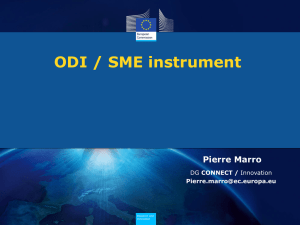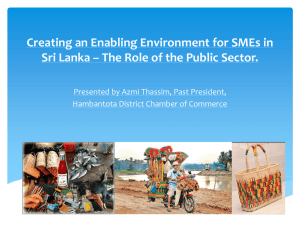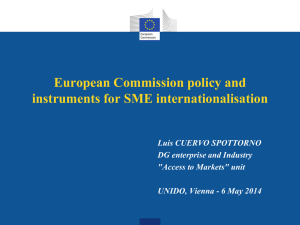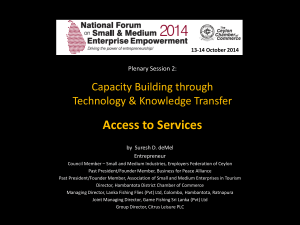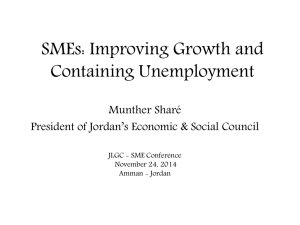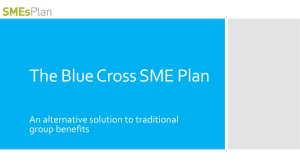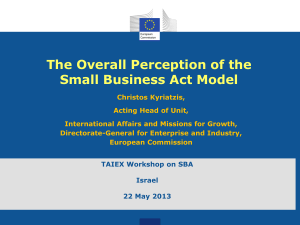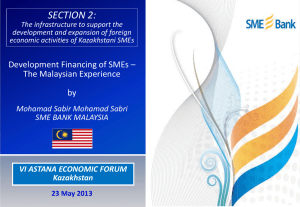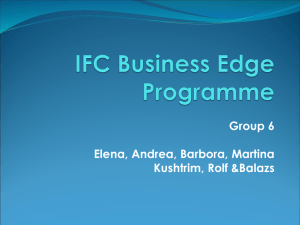SME finance vs. Microfinance - Transformational Business Network
advertisement
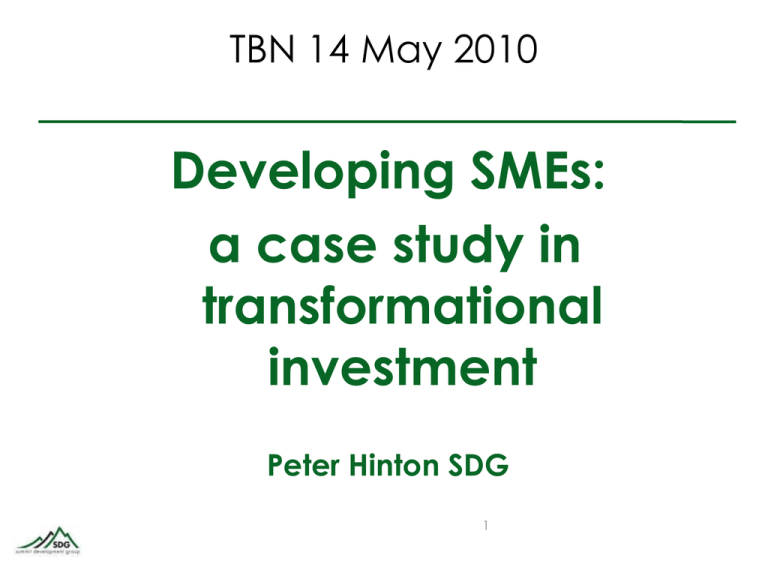
TBN 14 May 2010 Developing SMEs: a case study in transformational investment Peter Hinton SDG 1 Typical SME: Modern Radiators 2 Personal History Africa Trading 3 Missing middle opportunity Banking opportunity Missing Middle SMEs, Unbanked, Home buyers Micro finance Micro finance Potential clients Over served Micro finance MNCs Corporates Affluent Affluent Emerging propositions Middle income Neglected opportunity Mid– lower income Donor focus Missing Middle Poor Demographic Impact Less than $2bn in actively managed investment funds specifically target the SME sector, compared with over $6bn invested in microfinance sector 4 The majority of SMEs identify access to finance a major constraint Source: World Bank Enterprise Surveys. 2008 While SMEs tend to be banked, less than 30% have access to credit Source: World Bank Enterprise Surveys. 2008 Women SMEs • Access to credit in Kenya & Uganda 100% 10% 80% 60% 40% by women 90% by men 20% 0% 7 Microfinance vs. SME finance Microfinance customer SME customer 8 SME finance vs. Microfinance: Job creation $1 of SME finance creates 3 times more jobs than microfinance Investment size(US$ mn) Leverage (Deposits mobilized) Total assets available (US$ mn) Portion of assets for lending, 75% (US$ mn) Average loan (US$) Number of loans Jobs created per business over 5 yearsc Total jobs created Cost per job created (US$) Microfinancea 1 2x 2 1.5 317 4,732 1 4,732 211 SME banksb 1 8x 8 6 20,000 300 50 15,000 67 Source: a Averages for Sub-Saharan Africa based on 159 institutions surveyed in MixMarket 2008 Microbanking Bulletin b SDG estimates based on 2008 financial reports for 4 institutions in E. Africa: Development Finance Corporation Uganda and Finabank Group in Kenya, Rwanda, Uganda C SEAF estimate 26% annual employment growth; These calculations assume SME average employment of 20 with annual growth rate of 20% 9 SME finance vs. Microfinance: Financial statistics ROA ROE Total invested in sector (US$ bn) Average loan (US$) Loan portfolio (US$ mn) Average outreach per institution Microfinancea -3.2% -1.1% 4 317 2.6 32,616 SME banksb 2.1% 16.5% 1 20,000 243.4 3,043 Source: a Averages for Sub-Saharan Africa based on 159 institutions surveyed MixMarket 2008 Microbanking Bulletin; Deutsche Bank 2007 report b SDG estimates based on 2008 financial reports for 4 institutions in E. Africa: Development Finance Corporation Uganda and Finabank Group in Kenya, Rwanda, Uganda; IFC 2007 10 ‘Missing Middle’ Finance drives sustainable economic growth Expansion of formal financial inclusion for : ― ― ― SMEs and SME employees Unbanked Low- /middle-income homebuyers Deepening of financial market and enhancing country financial structure Strengthen capacity of management and employees of FIs and SMEs Job creation and contribution to tax base Source: SEAF 2007, From Poverty to Prosperity: Understanding the Impact of Investing in Small and Medium Enterprises 11 Channels of SME investment Direct – eg Cocoa farms in Ghana Through SME funds eg I&P, Fusion Through MFIs upscaling Through financial intermediaries eg banks with an SME focus Source: SEAF 2007, From Poverty to Prosperity: Understanding the Impact of Investing in Small and Medium Enterprises 12 SME Banking: Case study 13 SDG Business Model: FI Transformation Transform FI’s into leading local/SME banks Unfocused Underperforming Undermanaged Governance Management Poor Credit Quality Culture/ Leadership Weak IT Small Capital base Branding Marketing Controls Balance sheet building Processes & procedures Missing Middle Market Focus Credit management Risk management Sub scale Product range Distribution channels 12 Transformation Aspects 14 SME multiplier effect - latrines 15 SME Multiplier effect - schools 16 Impact Investing (10 Years) 1.1Job INVEST $1,000 $6,200 return (IRR 20%) 17 Conclusion SMEs are key to development On the ground contact is key Banks can be a key channel Multiplier effect is significant Commercial returns, development impact 18 Peter Hinton phinton@summitdevgp.com www.summitdevgp.com

